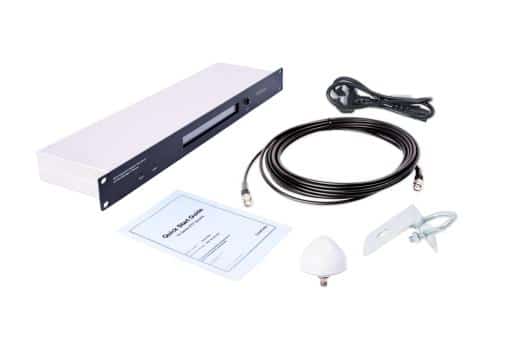A NTP appliance (Network Time Protocol appliance) is a dedicated hardware device designed to provide highly accurate, reliable, and secure time synchronization to computers, servers, and network devices within an organization.

Purpose
The main goal of a hardware NTP appliance is to ensure that every device on a network has the same, precise time. Synchronization is essential for many applications, such as: Log synchronization (security, auditing, forensics), Financial transactions, Telecommunications, Industrial control systems and Network management.
How NTP Server Appliances Work
The appliance typically obtains very accurate time from an atomic clock referenced time source, such as:
- GPS satellites.
- GNSS satellites (GPS, Galileo, GLONASS, Beidou).
- Radio time signals (like WWVB, DCF77, or MSF).
- Other external NTP servers.
It then acts as an authoritative NTP server on your local network, distributing precise time to other devices via the Network Time Protocol (NTP).
The device often includes:
- Single or multiple network interfaces.
- Holdover oscillators (e.g., TCXO, OCXO or Rubidium) that maintain accurate time even if GPS signals are lost temporarily.
- Built-in redundancy and failover.
- Security features to maintain timing integrity.
Security & Reliability
A professional NTP server appliance provides a number of features that enhances security and reliability.
- Protection against time spoofing or tampering.
- Support for NTPv4 with authentication.
- Logging and monitoring capabilities.
- Stratum 1 accuracy (directly connects to an atomic clock referenced time source).
Hardware NTP Servers Versus Software-Based NTP Servers
A software-based NTP Server is a general-purpose computer or VM running NTP software, such as chronyd, ntpd, or systemd-timesyncd that synchronizes its clock with external NTP sources and then serves time to clients. A Linux or Windows server configured as an NTP stratum 2 or 3 source is an example of a software-based NTP Server.
The difference between NTP server appliances and software-based NTP servers mainly comes down to time-source, accuracy, reliability, security, and cost.
Time Source
A NTP server requires an accurate and reliable source of time. A hardware appliance has a primary time source that is referenced to an atomic clock standard, such as GPS, GNSS or radio time references. They have an independent time source.
Software-based NTP Servers synchronise to other NTP servers over the internet or LAN to become a Stratum 2/3 time reference. Their source of time depends on upstream NTP sources.
Typical Accuracy
Atomic clock referenced time sources (Stratum 0) provide time to within ±30 nanoseconds to a few microseconds. While upstream NTP servers are limited to ±1–10 milliseconds (LAN) or ±10–100 ms (Internet).
Drift Tolerance
When a NTP device loses contact with it’s primary source of time, it’s system clock will drift away from the correct time.
Dedicated NTP Appliances have temperature-compensated oscillators (TCXO) or Oven Controlled Oscillators (OCXO) to minimize system time drift and maintain an accurate time.
Software-based solutions rely on standard crystal oscillators (XO) which have moderate to high drift and cannot maintain accurate time for an extended period.
Reliability and Security
A hardware NTP device provides a number of reliability and security advantages over software solutions.
The security surface of a hardware device can be much smaller, running reduced or minimal firmware. Software solutions often depend on a larger or full operating system with more attack vectors.
Network isolation is possible with dedicated hardware, providing a fully air-gapped solution with a GPS or GNSS time reference. A software solution needs external connectivity with an upstream, possibly internet, NTP server to provide time.
Enhanced security is provided by security hardened NTP devices. Software solutions cannot provide the same degree of OS hardening.
Cost and Maintenance
The cost of GPS/GNSS NTP server devices varies significantly. GPS referenced TCXO based devices can cost as little as $1000. While multi-GNSS referenced devices with Rubidium Oscillators can cost as much as $10,000. Installation costs can also be moderately high due to the requirement that a GPS/GNSS antenna ideally should be roof-mounted with a good sky view.
Maintenance costs of a hardware solution are minimal. Only firmware updates and occasional inspection of antennas and cabling are required.
Software based NTP solutions are available at very low cost. However, the cost of a LINUX or Windows server to host the software should be considered. Installation and setup costs can be moderately high, requiring OS configuration, tuning, and monitoring. Maintenance can also be time consuming, requiring regular OS patching and time source verification
Use Case Scenarios
NTP appliances are often used in industries where regulatory compliance and high-accuracy is required, such as financial trading, pharmaceuticals and telecommunications. They are also used in high-security scenarios where network isolation is necessary, e.g. SCADA, security and Industrial Control Systems.
Data centres and cloud infrastructure may use a hybrid architecture, with hardware Stratum-1 servers feeding internal software Stratum 2 servers.
Lab or test environments may employ software NTP servers where critical timing is not so much of a requirement.
Hybrid Architecture
Best practice is to use a hybrid architecture with 1–2 GPS or GNSS sourced hardware Stratum 1 servers and several software Stratum 2 servers synchronized to the appliances.
All clients synchronize to the Stratum 2 servers internally. The adoption of a hybrid architecture provides:
- High accuracy
- Internal redundancy
- Isolation from the Internet
- Lower cost scalability
Additional Resources
https://www.ntp.org/support/vendorlinks

Accurately synchronise the time on computers and network infrastructure in your organization with TimeTools TA310 GPS Network Time Server. The TA310 is designed and manufactured in the UK, and provides:
- Advanced, 92 Channel, GPS Receiver For Reliable Reception Of The GPS Satellite System.
- Security-Hardened, Enterprise-Class, Stratum-1 NTP v4 Network Time Server.
- Ultra-Fast, 50,000 NTP Polls Per Second (3M Per Minute), For Precise Client Synchronization.
- High-Stability, Temperature-Compensated Crystal Oscillator (TCXO) For Extended Stratum-1 Operation In The Event Of Any Loss of GPS Signal Lock.
- Network-Optimized Gigabit Ethernet (GbE).
- Powerful, Easy To Use, Web Interface With Command Line Interface For Advanced Users.
- CE and UKCA Compliant With Full EMC and Electrical Safety Test Reports.